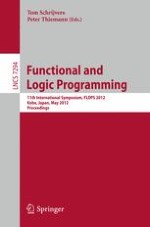2012 | Buch
Functional and Logic Programming
11th International Symposium, FLOPS 2012, Kobe, Japan, May 23-25, 2012. Proceedings
herausgegeben von: Tom Schrijvers, Peter Thiemann
Verlag: Springer Berlin Heidelberg
Buchreihe : Lecture Notes in Computer Science
